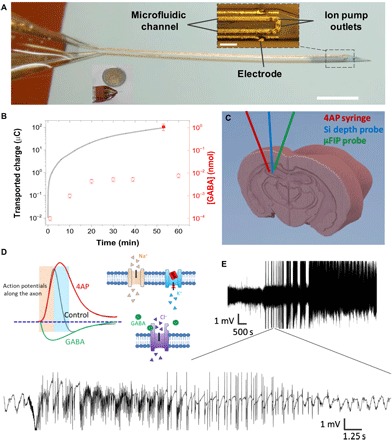Published online 2018 Aug 29
Authors: Christopher M. Proctor, Andrea Slézia, Attila Kaszas, Antoine Ghestem, Isabel del Agua, Anna-Maria Pappa, Christophe Bernard, Adam Williamson, and George G. Malliaras
“The persistence of intractable neurological disorders necessitates novel therapeutic solutions. We demonstrate the utility of direct in situ electrophoretic drug delivery to treat neurological disorders. We present a neural probe incorporating a microfluidic ion pump (μFIP) for on-demand drug delivery and electrodes for recording local neural activity.”
…
“In this work, we show that electrophoretic drug delivery can overcome the above problems by coupling the benefits of a highly localized, on-demand treatment with drugs that specifically control cellular functions. We demonstrate the therapeutic potential using epilepsy as a model system. Epilepsy, which affects 1% of the world population and remains drug-resistant in 30% of the cases (10, 11), is a prototypical example for which systemic drugs have failed in the clinic despite having strong antiepileptic effects because of their side effects, toxicity, and/or failure to cross the blood-brain barrier (12). The intermittent nature of epileptic seizures makes the disorder particularly well suited for a therapeutic approach such as electrophoretic drug delivery that acts only when needed, for instance, just before the onset of a seizure.
Here, we present an electrophoretic drug delivery device based on the organic electronic ion pump (OEIP), which offers the ability to deliver drugs with precise spatiotemporal control (13, 14). In contrast to other drug delivery devices, the ion pump works by electrophoretically pumping ions across an ion exchange membrane and thereby delivers only the drug of interest and not the solvent (aside from a few water molecules per ion that make up the hydration shell). This “dry” delivery is of paramount importance for biological interfacing as it enables an intimate interface between the drug delivery outlet and the target cells, allowing large amounts of drug delivery with negligible local pressure increase. Previous reports of OEIPs have shown much promise for interfacing with biology; however, challenges in scaling down these devices have limited their in vivo applications within the brain to date

Looking ahead, we believe that electrophoretic drug delivery devices can be further adapted to best treat epilepsy and other neurological disorders. While epilepsy is particularly challenging as it presents in many forms, it has been found that approximately 60% of the patients have a single focal point (45), and these are the patients that are most likely to find conventional drug treatments inadequate (46). Thus, a single μFIP implant at the seizure focus may prove a viable treatment option for these patients. On the other hand, patients with nonfocal epilepsy may benefit from the use of multiple μFIP implants and/or a single implant with multiple drug delivery outlet locations. In addition to epilepsy, we foresee that a μFIP implant could be used, for instance, to deliver dopamine for the treatment of Parkinson’s disease with the possibility of using integrated recording sites to optimize the dosing frequency. Likewise, a μFIP implant could deliver chemotherapeutic agents to an inoperable brain tumor and/or to the tissue surrounding a resected tumor. These topics will be the subject of future research” ( Proctor et al., 2022)
About 30% of the epileptic population has the medication-resisting type. The seizures do not react to any drugs and the seizures will continue. The issue here is a failed crossing of the brain barrier and the drugs are not able to be delivered where they need to go This ion pump implant described in the article addresses this 30%’s concerns. Finally a way to control their seizures, in theory. The device will allows diffusion to occur and a more localized drop of drugs to the point of seizure activity on the brain. We can even look past epilepsy and open this technology up to other neurological conditions. Delivery drugs straight to the brain seamlessly is quite a massive feat. So many conditions can adapt this technology for there own personalized use. For epilepsy, advancements come with a chance of a less painful life and more quality of life. Knowing this technology is out there, making strides, I do not feel like I’m overstepping I want to push it further.
Reference
Proctor, C. M., Slézia, A., Kaszas, A., Ghestem, A., del Agua, I., Pappa, A.-M., Bernard, C., Williamson, A., & Malliaras, G. G. (2018). Electrophoretic drug delivery for seizure control. Science Advances, 4(8). https://doi.org/10.1126/sciadv.aau1291



